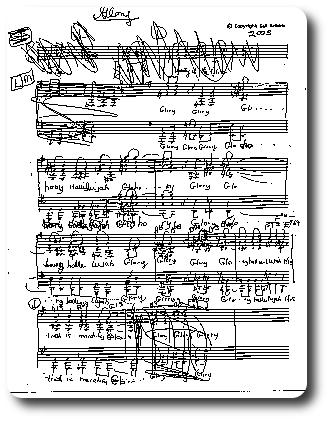|
Main Page About Gail About my CDs
|

Battle Hymn of the Republic
Lyrics : Julia Ward Howe, 1819-1910
Recording and Mixing Progress
As well as providing song previews in MP3 format as above, we are starting to try out a new format for song downloads - Ogg Vorbis, which is an alternative to the common MP3 format. We have found that Ogg Vorbis audio files are of a higher quality than comparable MP3 files. It is possible that your media player already supports Ogg format if you are using WinAmp in Windows or iTunes on a Mac. If you are, try downloading and playing the Ogg versions of Battle Hymn of the Republic and see if you can hear the difference:
Background about Battle Hymn of the Republic:This story begins with John Brown, born in Kansas, 1800. He and his family were slave abolitionists who raided the town of Harper's Ferry, West Virginia in 1859. Storming through that very surprised community, the Browns ambushed prominent citizens, took them as hostages and wrested control of the town's arsenal. The family's ill-fated intention was to liberate some of the local slaves and build an army with them to free the rest of the slaves throughout the south.Mr. Brown's rather disorganized "army" was soundly captured on October 18th, 1859. The hapless John Brown was tried, convicted and executed by hanging. The event, which caught the attention of the entire nation, sparked the American civil war that raged from 1861 to 1865. Julia Ward Howe desperately wanted to be useful and do her part in the war effort. Other women had husbands and sons fighting in the army. They embraced the cause and gathered their forces to serve in hospitals or wherever they were needed. Mrs. Howe's own husband was too old for duty and their children too young and dependent. Mrs. Howe was in Washington with her family during the war and one day heard soldiers lustily singing "John Brown's body lies a-mouldering in the grave". She was immediately encouraged by a friend sitting beside her to write perhaps more inspirational, less gruesome words to this camp meeting tune. As she lay in her bed, one evening in 1862, the verses swarmed her mind. She leaped out of bed and excitedly scribbled them on paper in the dark since she didn't wish to wake the baby by lighting her lamp. When Mrs. Howe completed her verses, she returned to bed, telling herself that she quite liked this song better than almost anything else she had ever penned. Later, at a big war rally attended by President Abraham Lincoln, a singer peformed Julia Ward Howe's "Mine Eyes Have Seen the Glory" and the audience went crazy with applause. With tears of emotion glistening in his eyes, the President shouted loudly "play it again!".
Arranging and Performance Notes for Battle Hymn of the Republic:While perusing the finished score, I was struck by all the key changes I somehow managed to stuff into this arrangement. Holy cow! Here's the roundup.Intro:
Studio Recording Notes:To be added later... stay tuned...
Mixing Details:To be added later... stay tuned... |
|||||||||